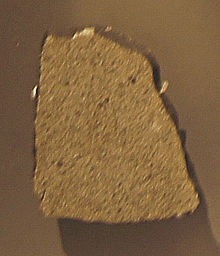Sylacauga (meteorite)
| Sylacauga | |
|---|---|
 A slice of the meteorite, the National Museum of Natural History, the Smithsonian, DC | |
| Type | Chondrite |
| Class | Ordinary chondrite |
| Group | H4 |
| Country | United States |
| Region | Alabama |
| Coordinates | 33°11′18.1″N 86°17′40.2″W / 33.188361°N 86.294500°WCoordinates: 33°11′18.1″N 86°17′40.2″W / 33.188361°N 86.294500°W |
| Observed fall | Yes |
| Fall date | 18:46 UT on November 30, 1954 |
| TKW | 5.54 kg |
| Strewn field | Yes |
The Sylacauga meteorite fell on November 30, 1954, at 12:46 local time (18:46 UT)[1] in Oak Grove, Alabama, near Sylacauga. It is commonly called the Hodges meteorite because a fragment of it struck Ann Elizabeth Fowler Hodges (1920–1972).[2]
Importance[]
The grapefruit-sized fragment crashed through the roof of a farm house, bounced off a large wooden console radio, and hit Hodges while she napped on a couch.[3] The 34-year-old woman was badly bruised on one side of her body, but was able to walk. The event received worldwide publicity.
The earliest claim of a person being hit by a meteorite comes from 1677 in a manuscript published at Tortona, Italy, which tells of a Milanese friar who was killed by one, although its veracity is unknown.[4] In 1992 a small meteorite fragment (3 g) hit a young Ugandan boy in Mbale;[5] it had been slowed by a tree and caused no injury.
Fireball[]
The meteor made a fireball visible from three states as it streaked through the atmosphere, even though it fell early in the afternoon.[6] There were also indications of an air blast, as witnesses described hearing "explosions or loud booms".[7]
Following events[]
The meteorite was confiscated by the Sylacauga police chief who then turned it over to the United States Air Force.[8] Both the Hodgeses and their landlord, Bertie Guy, claimed ownership of the rock, Guy's claim being that it had fallen on her property.[8] There were offers of up to $5,000 for the meteorite.[citation needed] The Hodgeses and Guy settled, with the Hodgeses paying $500 for the rock.[8] However, by the time it was returned to the Hodgeses, over a year later, public attention had diminished, and they were unable to then find a buyer.[8]
Ann Hodges was uncomfortable with the public attention and the stress of the dispute over ownership of the meteorite.[9] The Hodgeses donated it to the Alabama Museum of Natural History in 1956.[8]
The day after the fall, local farmer Julius McKinney came upon the second-largest fragment from the same meteorite.[10] An Indianapolis-based lawyer purchased it for the Smithsonian Institution.[10] The McKinney family was able to use the money to purchase a car and a house.[10]
Fragments[]
Upon the entry into the atmosphere, the Sylacauga meteorite fragmented into at least 3 pieces:[1]
- The Hodges fragment (3.86 kilograms (8.5 lb) - 33°11′18.1″N 86°17′40.2″W / 33.188361°N 86.294500°W) struck Ann Elizabeth Hodges.[11]
- The McKinney fragment (1.68 kilograms (3.7 lb) - 33°13′08.4″N 86°17′20.7″W / 33.219000°N 86.289083°W) was found the next day December 1, 1954 by Julius Kempis McKinney.[10]
- A third fragment is believed to have impacted somewhere near Childersburg (a few km north-west of Oak Grove).
Classification[]
The Sylacauga meteorite is classified as an ordinary chondrite of H4 group.[2]
Orbit[]
The meteoroid came in on the sunward side of the Earth, so when it hit, it had passed the perihelion and was traveling outward from the Sun. Considering the orbit estimations, the best candidate as parent body is 1685 Toro.[1]
See also[]
References[]
- ^ Jump up to: a b c Povenmire, H. (1995). "The Sylacauga, Alabama Meteorite: The Impact Locations, Atmosphere Trajectory, Strewn Field and Radiant". Abstracts of the Lunar and Planetary Science Conference. 26: 1133. Bibcode:1995LPI....26.1133P.
- ^ Jump up to: a b Meteoritical Bulletin Database: Sylacauga
- ^ Grundhauser, Eric (2 June 2015). "The Meteorite That Landed on a Woman in Alabama". Slate. Retrieved 29 June 2015.
- ^ "Zeus Displeased". Futility Closet. January 12, 2010. Retrieved July 3, 2014.
- ^ "The Mbale Meteorite Fall". Dutch Meteor Society. 2002. Retrieved July 3, 2014.
- ^ Swindel, G.W.; Jones, W.B (1954). "The Sylacauga, Talladega County, Alabama, Aerolite". Meteoritics. 1 (2): 125–132. Bibcode:1954Metic...1..125S. doi:10.1111/j.1945-5100.1954.tb01323.x.
- ^ Underwood, Madison (February 15, 2013). "Russian meteorite blast recalls the Alabama woman struck by a meteorite in 1954". al.com. Retrieved February 16, 2013.
- ^ Jump up to: a b c d e Nobel, Justin (February 20, 2013). "The True Story of History's Only Known Meteorite Victim". National Geographic.
- ^ Nobel, Justin (20 February 2013). "The True Story of History's Only Known Meteorite Victim". National Geographic. Retrieved 3 May 2015.
Ann later suffered a nervous breakdown, and in 1964 she and Eugene separated. She died in 1972 at 52 of kidney failure at a Sylacaugan nursing home. Eugene suspects the meteorite and frenzy that followed had taken its toll on Ann. He said 'she never did recover,' according to the museum. Ann 'wasn't a person who sought out the limelight,' added museum director Randy Mecredy. 'The Hodges were just simple country people, and I really think that all the attention was her downfall.'
- ^ Jump up to: a b c d Ellington, M.J. (November 30, 2006). "A star fell on Sylacauga: '54 meteorite struck home, woman, changed lives". The Decatur Daily. Retrieved July 3, 2014.
- ^ Blackwell, Phil. "10 Unlikely Events That Actually Happened". The Perch. The Perch. Retrieved 7 November 2016.
External links[]
- Meteorites by name
- Chondrite meteorites
- Meteorite falls
- Strewn field (meteorite)
- 1954 in science
- 1954 in the United States
- Geology of Alabama
- Meteorites found in the United States
- November 1954 events

